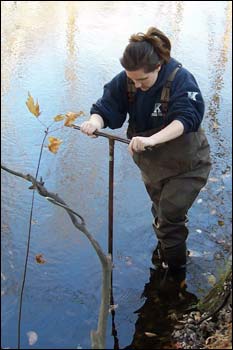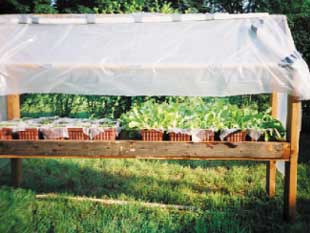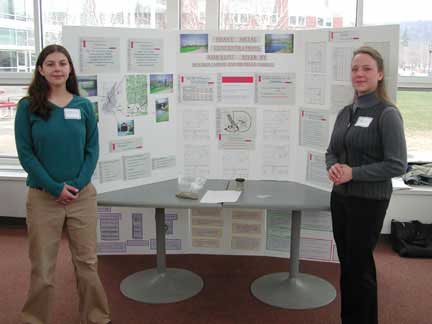Research on Lead and other metals
in Sediments and Soils
Timothy Thorpe Allen, Ph.D., P.G.
Student Projects
Most of these projects were presented at the annual Keene State College Acadamic Excellence Conference, and many have been incorporated into published abstracts of presentations given at regional scientific meetings, or peer-reviewed journal articles.
Contamination of Soils on the KSC Campus from Lead Paint (2008)
Nasra Al-Hashmi, Emily Archer, Lauren Cram, Anthony Daniels, Joshua Decknick, Jaclyn Oster, Aileen Shaw, Joshua Starkey, Melissa Sweeney, Thomas Zimmerman, Michael Avery, Geoff Cornell, Keith Donovan, Jon Paquette, Nicholas Raymond, Sena Tay, and Dene Tully
Recently the KSC Child Development Center playground was found to be contaminated with chips of leaded paint. Lead exposure is known to cause severe health effects in children. We were engaged to determine how widespread this problem is across the rest of the campus. We collected samples of paint chips and soils from around the perimeter of selected buildings built prior to the banning of lead paint. Paint chips were qualitatively scanned for the presence of lead using X-ray fluorescence spectrometry (XRF). Soil samples were dried, pulverized and pressed into powder pellets, which were then quantitatively analyzed for total lead concentration by XRF. All of the paint chip samples scanned had lead present. Soil lead concentrations range from 109 mg/kg to 22,486 mg/kg. Most of the buildings have soil lead levels well above the US-EPA's recommended action levels of 400 mg/kg for play areas, and 1200 mg/kg for non-play areas.See also Allen, 2008, under Published Abstracts and Papers, below. This work was also reported on by the Keene Equinox Newspaper, Tests Reveal Lead Elsewhere on Campus
The Extent of Areas Containing High Concentrations of Lead and Copper in the Ashuelot River Sediments (2005)
Erin Burns
Lead and Copper are heavy metals which in high concentrations are toxic to plants and animals. The Ashuelot River in New Hampshire runs through many communities including the historically industrialized city of Keene. A previous study, done by Allen and others (2003), found that in certain sections of the river, sediments contain levels of Copper and Lead higher than the "Upper Effects Threshold" as defined by the National Oceanic and Atmospheric Administration's Coastal Protection and Restoration Division (Buchman, 1999). This study builds upon this precursor by to confirming the high levels of lead and copper in these areas as well as the extent of these areas. The sediments are analyzed by X-ray Fluorescence Spectrometry in order to construct a cross-section of the areas of concern.

See also Allen & Burns, 2006, under Published Abstracts and Papers, below.
Phytoremediation of Lead in Ashuelot Riverbank Soil Using Brassica juncea (2004)
Sarah Ritter
Past studies have found that the sediments in the Ashuelot River at the Keene State College Railroad Trestle have high levels of lead. This leads to the possibility that the banks of the Ashuelot River may also have high levels of lead. Exposure to lead is dangerous to the health of humans and to the environment, so an experiment was created that attempted to reduce the levels of lead in the soil of the banks of the Ashuelot River through phytoremediation. Phytoremediation is the process of plants removing contaminants from the soil by absorbing the contaminants into the plant itself. The plant Brassica juncea, "Indian Mustard" grew in pots of soil collected from the banks of the Ashuelot River. The collected plant and soil samples were analyzed for lead content by x-ray fluorescence spectrometry.

Certain plants, such as Indian Mustard (Brassica juncea), are known to hyper-accumulate some metals, thus reducing the amount of these metals in the soil. In phyto-remediation, these plants are used to clean up contaminated soils. After the plants have absorbed the contaminant, the plants are dug up, dried, and properly disposed of in landfi lls. Thousands of cubic yards of contaminated soil can be reduced to just a few yards of dried plant material.
Environmental Studies student Sarah Ritter grew Indian Mustard plants in some soil known to have a high Lead content as well as a control soil, and over the course of the experiment analyzed both the plants and the soils for lead content using the XRF spectrometer. She found that plants grown in the lead-contaminated soil contained lead, while those grown in lead-free soil did not. Sarah also found that, over time, the total amount of lead contained in the plants grown in the lead-contaminated soil did increase (the plants were accumulating lead), although there was insufficient growth to significantly reduce the amount of lead in the soil. Next time, we'll give the plants some fertilizer!
Heavy Metal Concentration in Ashuelot River Sediments (2003)
Michelle Comeau and Heather Carson
A reconnaisance assessement of heavy metal contamination of sediments in the Ashuelot River, southwestern New Hamphire, using X-ray fluorescence spectrometer, suggests that there is widespread Nickel and Lead contamination all along the river. Significant concentrations of Lead are found at some sites within the city of Keene. Chromium contamination could not be determined quantitatively due to a problem in sample preparaton, but is suggested--particularly in Keene--by the results. Copper is generally low, except at one localized "hot spot," but becomes somewhat elevated downstream. Sediments enriched in Zinc slightly above expected background concentrations are widespread, but there are no extreme values.

See also Allen, et al., 2003, under Published Abstracts and Papers, below.
Published Abstracts and Papers
Allen , T., 2008, Contamination of Soils and Sediments in Keene, NH, from Lead Paint, Geological Society of America Abstracts with Programs, 40(2):8
Allen, T.T., and Burns*, E., 2006, Occurrence and Distribution of Trace-Metal-Contaminated Sediments in the Ashuelot River, Keene, N.H., Geological Society of America Abstracts with Programs, 38(2):12
Allen, T., M. Comeau*, H. Carson*, and E. Hurd*, 2003, A Reconnaissance of the Heavy Metal Content
of Ashuelot River Sediments, Studies in New England Geography, Number 17, 23 pages.
![]()
Posters ![]()
Manuscript ![]()
The research reported on here has been supported in part by the National Science Foundation through awards 0087860 and/or 0520938.
Contact Information
E-mail: tallen@keene.edu
Office Phone: 603-358-2571
Lab Phone: 603-358-2582
Mobile Phone: 603-209-9222
FAX: 603-358-2897
Mailing Address: Tim Allen, Mailstop 2001, Keene State College, Keene, NH 03435-2001
This website and all documents presented here were written by Timothy T. Allen in his private capacity. No official support or endorsement by the University System of New Hampshire or Keene State College is intended or should be inferred. Copyright © 1992-2011 Timothy T. Allen.
website by ThorpeAllen.net
December 2010
